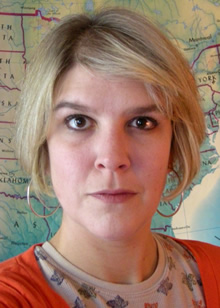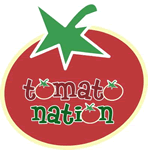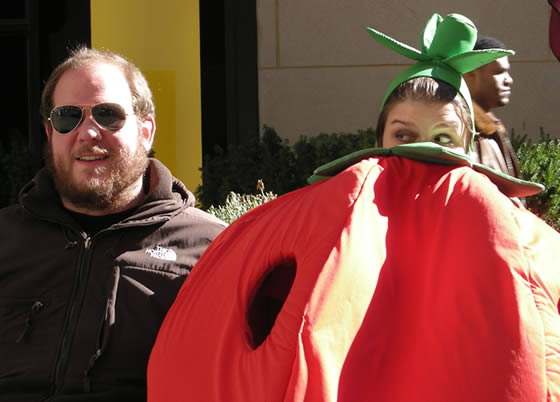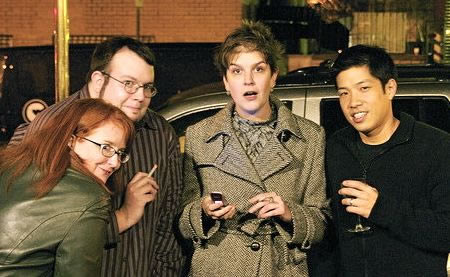
- Learn The Secrets Of Winning the DonorsChoose Social Media Challenge
- Read How To Dramatically Increase Your Fundraising Online
- Discover How Sarah Bunting From Tomato Nation Has Massive User Engagement & Monetization With A Small Amount Of Traffic
Full Interview Audio and Transcript
Personal Info
Hobbies and Interests: Watch, Read & Listen To Baseball, Reading, Sewing.
Sports teams: NY Yankees, NJ Devils.
Favourite Books:
- The Great Gatsby by F. Scott Fitzgerald
- In Search of Excellence: Lessons from America’s Best-Run Companies by Thomas J. Peters and Robert H. Waterman
Favourite Entrepreneurs: Her Father.
Twitter url: http://twitter.com/TomatoNation
Personal blog: http://tomatonation.com
Fast Track Interview
Adrian Bye: Today, I’m talking with Sarah Bunting from Tomato Nation. None of you have probably ever heard of Sarah. She doesn’t like it when I say this, but I don’t think she’s really very well-known. I don’t think her blog has a whole lot of traffic. Her blog, in fact, has a standard template from WordPress.
But the amazing thing that Sarah does, year after year, involves a giving challenge called DonorsChoose. Sarah comes along and just destroys all of the technology guys with donations she puts together through her little blog with not much traffic.
There are a lot of things that we can learn from what Sarah’s doing with fundraising and equally apply them to business. Sarah has a big story to tell, and I’m fascinated to hear it. Sarah, thanks for joining us.
 Sarah Bunting: Thank you for having me and my tiny blog with no traffic.
Sarah Bunting: Thank you for having me and my tiny blog with no traffic.
Adrian Bye: Let’s talk about your tiny blog with no traffic. You do get a lot of comments, but your blog has an Alexa rank of about 230,000 as of right now. Obviously, those can be distorted and inflated, but that would generally indicate a blog that has a few visitors a month. Am I wrong?
Sarah Bunting: Well, it depends on the metrics that you’re using, of course. The ones I use show I’m getting 25,000 to 30,000 unique users a month.
Adrian Bye: If you have 25,000 to 30,000 visitors per month, we’re talking fewer than 1,000 visitors a day. By comparison, Craig Newmark, who runs craigslist, measures traffic in billions of paid views.
This is what I find impressive. In the most recent round of DonorsChoose, Craig was able to raise $13,850 from 13 donors, and Tomato Nation with Sarah was able to raise $374,036 from 1,132 donors. Fred Wilson, VC blogger in New York City, raised $38,733 from 217 donors. That’s one-tenth of what you’ve been raising.
Actually, before we get into your fundraising strategies, could you tell us a little bit about yourself and your blog?
Sarah Bunting: Sure. I’m a writer and an editor. I went to Princeton University and graduated with a Creative Writing degree. I ended up working various odd jobs before the internet presented a better option for me in terms of getting my work out there.
Fifteen years ago, it was very difficult for me to break into print, so I started a little website to just put my thoughts down. It was a way to keep the writing muscles warm while I was also making money as a records clerk.
After that, I built up various online presences. My day job for 10 years was a site I co-founded called "Television Without Pity." It was a television and pop culture review site that had a million unique users a month. As a result of that, I was freelancing for msnbc.com and various other off and online publications. My two Canadian partners and I sold the "Television Without Pity" site to Bravo a couple of years ago.
My blog, Tomato Nation, was launched in 1997, and I’ve continued to update that regularly for over a decade. I am much more of a generalist and write just about anything culture-related. I have an advice column. I tell stories about my cats. It’s about everything.
Adrian Bye: You make a blog post, and you get 200 responses to it. Where is your traffic coming from?
Sarah Bunting: It’s coming from endurance and duration of time. When I first started, I had three readers, and two of them were blood relatives. It was just the slow accruing of people who had one of my articles forwarded to them, they visited the site, and then they saw some things they liked in the archives and stuck around.
I really haven’t done mailing lists. I haven’t done SEO. It’s mostly just waiting for the flight to quality. Again the site was started in ’97, so the way you promoted yourself then was much different. Now, every time I have a new entry, it does go out on my Twitter stream or as a Facebook update.
For regular readers, I’m either on a bookmarks list, a reader aggregate stream, a part of their daily chore or they click on it out of Twitter. I don’t write posts with the traffic in mind, though. I write about what I want, and sometimes it strikes a chord.
Adrian Bye: Can you tell us a little bit about DonorsChoose and why you support that organization?
 Sarah Bunting: I heard about DonorsChoose by reading about it in The New Yorker in 2004. It was founded by a former New York City public school teacher in response to the fact that teachers were generally underfunded. Teachers in low-income schools didn’t have enough money for basic materials at times. They were running out of paper. They all had to share one copy of the textbook. They needed air purifiers. They needed desks. There was no money in the budget. This wasn’t something that the local PTAs could even provide.
Sarah Bunting: I heard about DonorsChoose by reading about it in The New Yorker in 2004. It was founded by a former New York City public school teacher in response to the fact that teachers were generally underfunded. Teachers in low-income schools didn’t have enough money for basic materials at times. They were running out of paper. They all had to share one copy of the textbook. They needed air purifiers. They needed desks. There was no money in the budget. This wasn’t something that the local PTAs could even provide.
DonorsChoose’s system is to solicit project proposals from the teacher, and then the teacher posts this proposal. For example, I need 50 reams of paper for my class. It costs $500. Then donors can donate the entire $500. They can donate $50. They can donate $5. You immediately see a difference on the proposal’s page that you have made this donation and that it is going directly to the classroom.
I am the product of 17 years of private schooling, including university, that my parents were able to pay for in full. My education was made a big priority by my parents, and they were able to give that to me, for which I’m very grateful.
But many people in this country don’t have that and are forced to rely on the public schools to educate their kids. There are public schools that would like to do that but they’re not able to and certainly there are no extras. Whole schools without arts programs. Whole schools without certain books that we took for granted and places where they pass around one book among 40 kids.
I found this organization very attractive because I have been lucky in this way, and this is clearly a need where a small investment pays off really big down the road for the entire society.
Adrian Bye: Can we talk a little bit about how the fundraising drive actually works? When do you start the drive and why did you pick that time?
Sarah Bunting: It’s held in October. The first year that my readers and I were involved with this was around the presidential elections in 2004.
Bush’s reelection was a grave disappointment to me and to many of my readers who are politically progressive. People were writing into the advice column saying, "How do I manage the next four years when I don’t share the values of Bush?"
When I first began this drive, it was in response to feeling powerless to affect anything as progressives, so I invited my readers to donate to DonorsChoose. I said, "I just read about this organization where you can give some money directly to a public school classroom. You can make a difference and you can feel like you exist in this system." I believe we raised $23,000 that time.
I was then invited into the DonorsChoose offices to tell them how I had managed to raise that money. DonorsChoose then launched what they now call the Social Media Challenge as a kind of throw down between all these various blogs. It takes place from October 1 to October 31 every year.
Adrian Bye: You do a lot of work on your blog for the fundraising drive. Can you explain some of what you do and how it works?
Sarah Bunting: Every year, I do the fundraiser in the framework of a contest. For example, people can win things. It started with "Forward me your DonorsChoose receipts as your entry into the contest." People enjoy getting free stuff, and people also enjoy contributing free stuff for the contest.
That’s now kind of an excuse at this point. A lot of the readers don’t care whether they win anything. They feel like they’ve already won. The DonorsChoose setup and the feedback you get from the teachers and the students is extremely touching and rewarding for people. For some of them, they’re not participating to win prizes.
For the month of October, my blog is definitely about the contest. I do have to occasionally apologize to readers who don’t have much interest in it and say, "More regular programming will resume on November 1. Until then, we have kids who are counting on us! Let’s buy books!" Occasionally, I’ll post a movie review just so people don’t go away forever.
The other aspect about this fundraiser is that I actually bought a tomato outfit, and I always promise to do something crazy while dressed as a tomato. One year I did a little dance in Rockefeller Plaza. This year, I will be going to Atlantic City dressed as a tomato.
Adrian Bye: You actually make it fun and entertaining for people to be a part of the competition?
 Sarah Bunting: Right. You also have to signal to the readers that you believe that much in the project. One year, I shaved my head to the skin and promptly caught a cold right afterwards that lasted for two weeks.
Sarah Bunting: Right. You also have to signal to the readers that you believe that much in the project. One year, I shaved my head to the skin and promptly caught a cold right afterwards that lasted for two weeks.
My particular readership is not necessarily wealthy people but a lot of graduate students, college students or people who have enough money to get by but not a lot. When I’m willing to shave my head or buy a $300 vegetable outfit and prance around Washington DC, I signal to them that it is that important to me. That’s an article of faith with the readers that I take this very seriously.
I am also working extremely hard behind the scenes to keep all the prizing organized, to make sure all the donations are going where they’re supposed to go, and to be a liaison if people have questions about any aspect of the fundraiser.
Overall, though, it’s what the readers do and it’s what the charity does to be an attractive prospect. A big part of that is making them feel that the fundraiser is a community trust.
There’s also a psychology’s crowd aspect that I use. It’s a reverse psychology where I imply that, "I would really like you to reach $70,000 by today. You probably can’t do it, but it would be really great. If you haven’t donated yet, today would be a great day to do that."
Then there is usually this small piranhas-on-a-cow type flurry of donations where they feel that I have impugned their honor, and they will then get to $70,000 and show me who’s boss.
There’s also putting match points at key points in the fundraiser. Experience has shown me that after the initial excitement and that first big goal, for example, things tend to slow down. For example, once they get to $50,000, a lot of them sit back and feel like, "Okay, I’ve done my part."
That’s where you really have to give them the guilt. For example, my brother and his wife had a baby in June. My nephew is, by all objective measures, the cutest baby ever born. I was not afraid to dress him up in little outfits, including the tomato, put pictures of him on the site and say, "This is a future public school student. Do you want him to go without Hemingway in his English class?!" That did work on a couple of people who said, "I thought I’d emptied my pockets, but I found another $10."
There’re a bunch of things that I can do that work. Some of it comes from having five years’ experience, knowing how this particular crowd will behave, putting incentives at the points where they’re needed most, and just having faith that they can get it done.
That’s the amazing thing to me. It’s the trust that some of these larger donors put in this project, but initially it was something that they did on my say-so, which is a big responsibility.
Adrian Bye: How does it work with those larger donors? Do they approach you?
Sarah Bunting: It depends. I have a couple who are in my real-life circle that I’ve approached and can rely on every year. But the bigger donors really approached me.
In one case a large donor said, "I have a trust that was left to me for charitable giving. I would like to set up a system with the contest this year where if certain science projects are donated to, then I will donate a like amount."
Generally speaking, they approach me because they want certain projects from a certain part of the country or certain subject matter to be addressed, and they want to ensure that extra attention is given to that. In my daily post, I might say, "Here’re five projects we’re focusing on today in Detroit. Donors to this project can receive a special prize, and we will get extra money if these projects are completed."
That’s helpful motivationally, so the donors can feel they can control some of the money, which they can, and then we’re given an extra boost. This extra boost creates extra boosts of their own as people are inspired by a big jump in the number to become a part of it. It’s built on itself, and that’s very helpful.
Adrian Bye: Are there any other ways that we haven’t discussed in terms of how you make this work?
Sarah Bunting: I don’t think so. It is a lot of setup work on the front end and then clean-up work on the back end. People I’ve talked to have been a little surprised. They’re expecting to hear that I have some magic formula of "Here’s how you target your mailing list" or what have you.
Really it’s just sitting on this database for 16 hours a day, writing posts to motivate people, being funny and then being serious, and trying to hit the buttons that will get people involved and excited.
There’s also the fact that I can’t take full credit for any of it. It’s an excellent organization. It’s set up in a way that makes it very easy for me to sell it. It’s not obscure. You see a difference immediately. It’s an excellent organization, and all I had to do was stand next to it and point at it.
Adrian Bye: Well, you’re doing a little more than that.









